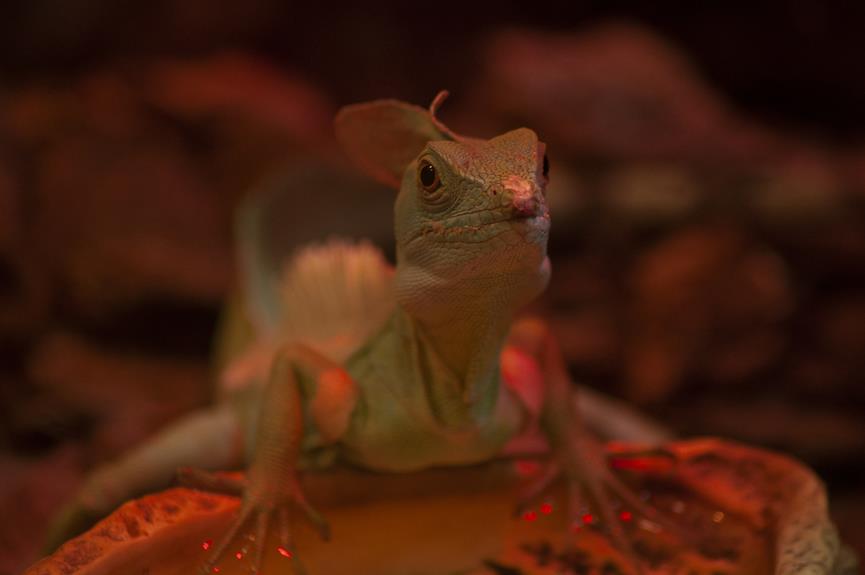Are you curious about the mysterious behavior of lizards? Well, buckle up because we’ve got the inside scoop on whether these scaly creatures play dead.
In this article, we’ll delve into the fascinating world of lizard survival strategies and uncover the truth behind their uncanny ability to mimic death.
Prepare to be amazed as we explore the evolutionary reasons and benefits of playing dead for these remarkable reptiles.
Get ready to uncover the truth about lizards’ captivating survival tactics!
Key Takeaways
- Lizards communicate through visual displays, vocalizations, and chemical signals.
- Playing dead is a survival strategy employed by lizards to avoid predation.
- Species that play dead have evolved adaptive camouflage mechanisms.
- Playing dead is a crucial defense mechanism for survival in harsh environments.
The Behavior of Lizards
We occasionally observe lizards displaying interesting behaviors in their natural habitats. Lizard behavior can vary depending on the habitat they inhabit. For instance, lizards in desert environments may exhibit different behaviors compared to those living in rainforests. This is due to the varying availability of resources and the challenges posed by different climates.
Lizards communicate with each other using a variety of methods. These include visual displays, such as head-bobbing or throat puffing, as well as vocalizations and chemical signals. These communication methods are crucial for establishing territories, attracting mates, and warning off potential predators.
Understanding lizard behavior and communication is essential for gaining control over their movements and interactions within their habitats. Now, let’s delve into the fascinating topic of understanding playing dead in lizards.
Understanding Playing Dead in Lizards
Observing lizards in their natural habitats, we’ve noticed the intriguing behavior of playing dead. This mimicry behavior, also known as thanatosis, is a fascinating survival strategy employed by various lizard species. Playing dead involves the lizard remaining motionless and appearing lifeless when faced with a potential threat. This behavior serves as a defense mechanism, allowing the lizard to avoid detection and potential predation.
Understanding mimicry behavior in lizards provides insight into the survival advantages of playing dead. By feigning death, lizards can deceive predators and divert their attention away from themselves. This gives the lizards an opportunity to escape or confuse their attackers. Additionally, playing dead can deter predators that rely on movement to identify prey, as immobile lizards may not trigger their hunting instincts.
Through our research, we aim to uncover the physiological and neurological mechanisms behind playing dead in lizards. This knowledge will contribute to our understanding of predator-prey dynamics and the evolution of defensive strategies in reptiles.
Species That Play Dead: a Closer Look
When examining species that play dead, we uncover a fascinating array of strategic survival tactics and adaptive camouflage mechanisms. These species have evolved the remarkable ability to mimic lifelessness, fooling predators into thinking they’re no longer a threat.
Through careful observation and scientific analysis, we can gain a deeper understanding of the intricate strategies employed by these animals to ensure their survival in the face of danger.
Strategic Survival Tactics
Our research revealed that some reptiles, like the horned lizard, employ strategic survival tactics such as playing dead to deceive predators. These camouflage techniques and predator avoidance strategies are crucial for their survival in the harsh environments they inhabit. By pretending to be lifeless, the horned lizard tricks its predators into thinking it is no longer a threat, allowing it to escape unharmed. This deceptive behavior is just one example of the many intricate survival mechanisms that reptiles have evolved over time.
To further understand the various tactics employed by reptiles, we have created a table below that showcases different types of camouflage techniques and predator avoidance strategies observed in reptilian species:
| Camouflage Techniques | Predator Avoidance |
|---|---|
| Cryptic coloration | False injury display |
| Mimicry | Startling behavior |
| Countershading | Tail autotomy |
| Disruptive coloration | Defensive odors |
Through the use of these techniques, reptiles are able to blend seamlessly into their surroundings, making it difficult for predators to detect them. Additionally, they employ various defensive behaviors and physical adaptations to deter attacks and increase their chances of survival. This fascinating array of strategies highlights the remarkable adaptability and resourcefulness of reptiles in the face of adversity.
Adaptive Camouflage Mechanisms
Let’s examine the adaptive camouflage mechanisms of various species that employ the tactic of playing dead. Adaptive camouflage is a remarkable survival strategy employed by many organisms that allows them to blend seamlessly into their surroundings, making them virtually invisible to predators.
Mimicry plays a crucial role in this tactic, as these species mimic the appearance of non-living objects or dead organisms, effectively fooling their predators into thinking they pose no threat. This form of adaptive camouflage not only enhances their chances of survival but also allows them to evade detection and capture.
Evolutionary Reasons for Playing Dead
We can understand why animals might play dead by examining the evolutionary advantages it provides. Playing dead is a deceptive tactic used by various animals, including lizards, to enhance their chances of survival.
When faced with a threat, lizards may freeze their body and remain motionless, mimicking a lifeless state. This behavior serves as a survival strategy by confusing predators and reducing the chances of being attacked.
By feigning death, lizards can avoid detection and increase their chances of escaping unharmed. This evolutionary advantage allows lizards to exploit their environment effectively, as it provides them with a means of evading danger.
The ability to play dead has likely been honed through natural selection, as those lizards that successfully employ this deceptive tactic have a higher likelihood of passing on their genes to future generations.
Benefits of Playing Dead for Lizard Survival
Playing dead is a clever strategy employed by lizards to trick predators and increase their chances of surviving unscathed. This behavior provides an evolutionary advantage by allowing lizards to avoid becoming prey.
When faced with a potential threat, lizards often freeze their bodies, collapse to the ground, and remain motionless for extended periods. This mimicking of death is an effective predator avoidance mechanism, as it tricks predators into thinking the lizard is no longer a viable target.
By staying still and appearing lifeless, lizards decrease their visibility and reduce the likelihood of being detected by predators. This tactic not only increases their chances of escaping unharmed but also allows them to conserve energy for other essential activities.
Now, let’s delve into how lizards mimic death and the intricate details of this fascinating survival strategy.
How Lizards Mimic Death
Lizards have developed a fascinating survival strategy known as death mimicry. When faced with a threat, these reptiles are able to mimic death so convincingly that predators are often fooled.
This mimicry is achieved through a combination of behavioral and physical adaptations, such as freezing in place, collapsing onto their sides, and even emitting a foul odor to further enhance the illusion of death.
Survival Benefits of Mimicry
It’s fascinating how some animals, like lizards, can cleverly mimic death as a survival strategy. This adaptive mimicry is a remarkable defense mechanism that aids in predator avoidance.
When faced with a potential threat, certain species of lizards exhibit an extraordinary ability to play dead, fooling predators into thinking they’re no longer a viable prey item. By remaining motionless, these lizards effectively blend into their surroundings, making it difficult for predators to detect them.
This strategy allows them to escape the attention of their would-be attackers, giving them a higher chance of survival. The ability to mimic death is a testament to the incredible adaptability of these reptiles, enabling them to navigate and thrive in their natural environments.
Trigger Mechanisms for Mimicry
Although we mightn’t fully understand the trigger mechanisms for mimicry in lizards, it’s clear that their ability to mimic death is an impressive survival adaptation. Lizards have evolved sophisticated mechanisms to deceive predators and increase their chances of survival. Here are four key factors that contribute to their successful mimicry:
-
Visual cues: Lizards rely on their ability to blend into their surroundings using adaptive camouflage. By mimicking the appearance of a lifeless creature, they become inconspicuous and less likely to be detected.
-
Behavioral cues: When threatened, lizards exhibit specific behaviors associated with death, such as remaining motionless and limp. These actions convince predators that they’re no longer a threat, effectively deterring further attacks.
-
Chemical cues: Some lizards release chemical compounds that imitate the smell of decaying flesh. This further enhances the illusion of being dead, repelling predators that rely on olfactory cues.
-
Contextual cues: Lizards are highly attuned to their environment and adjust their mimicry behavior accordingly. They assess the level of threat and respond accordingly, ensuring the effectiveness of their survival strategy.
Understanding the trigger mechanisms behind lizard mimicry is a fascinating area of research, with potential applications in the field of biomimicry and camouflage technology. By unraveling the intricacies of this adaptive trait, we can gain valuable insights into nature’s mechanisms for survival.
Debunking Myths: Can All Lizards Play Dead?
We’ve been researching various lizard species to determine if all of them have the ability to play dead. The playing dead stereotype is a common misconception about lizards, and our goal is to debunk this myth by examining the role of environmental factors in playing dead behavior.
Our studies have shown that while some lizard species do indeed exhibit this behavior, it isn’t universal across all species. Environmental factors such as predator presence, habitat type, and specific adaptations play a significant role in determining whether a lizard will employ this survival strategy.
Frequently Asked Questions
Can Lizards Play Dead as a Defense Mechanism?
Yes, lizards can play dead as a defense mechanism. It is one of their survival strategies. When faced with a potential threat, lizards may exhibit thanatosis, a behavior where they feign death to avoid being detected or attacked.
How Long Can a Lizard Stay in a "Dead" State?
Lizards can stay motionless for extended periods, fooling predators with their ‘dead’ act. It’s fascinating to note that some species, like the Texas horned lizard, can remain in this state for up to 30 minutes!
Do All Lizard Species Have the Ability to Play Dead?
Lizard species have a fascinating ability to employ a playing dead mechanism. This mechanism allows them to deceive predators and potentially avoid being attacked. It is an intriguing behavior that showcases the adaptability of these reptiles.
Are There Any Other Animals That Mimic Death Like Lizards?
Insects, like some beetles and bugs, can mimic death as a defense mechanism. As for reptiles, there are other species that play dead, such as certain snakes and turtles, using this tactic to avoid predation.
What Are the Specific Physiological Changes That Occur When a Lizard Plays Dead?
When a lizard plays dead, there are specific physiological changes that occur. These behavioral adaptations include reduced heart rate, shallow breathing, and muscle relaxation, allowing the lizard to convincingly mimic death and avoid predators.
Conclusion
In conclusion, the fascinating behavior of lizards playing dead showcases their remarkable adaptability and survival strategies. Through meticulous mimicry and a clever evolutionary advantage, certain lizard species have mastered the art of deception. This skillful act not only confuses predators but also provides essential benefits for their own survival.
Despite popular belief, not all lizards possess this remarkable ability. Nonetheless, the phenomenon of lizards playing dead offers a captivating insight into the intricate world of reptilian behavior.


